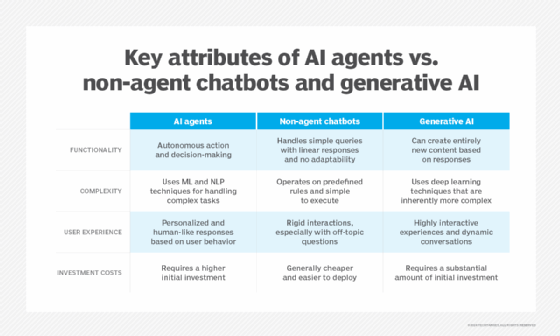What is agentic process automation?
Agentic process automation, also known as agentic automation, is an automation approach that integrates autonomous AI agents and advanced AI technologies to perform tasks with minimal human intervention.
Agentic automation differs from traditional rule-based systems that rely on static instructions. Using adaptable artificial intelligence technologies, such as generative AI, large language models (LLMs) and large action models, agentic automation systems thrive in unpredictable environments. These systems make context-aware decisions, take appropriate actions and operate autonomously to ensure smooth process management.
Agentic automation systems continuously learn from their experiences to improve their decision-making processes over time. They're designed not only to perform repetitive tasks, but also to understand, learn and ultimately solve problems and make independent decisions.
How agentic process automation works
Agentic process automation bridges the gap between traditional automation and AI. It lets organizations achieve greater efficiency and scalability. The following is a step-by-step overview of how it works:
- Goal definition. A user defines a specific high-level goal or task, such as processing invoices or managing customer inquiries.
- Data collection. Once goals are defined, the next step is to gather relevant data. Automation agents collect information from various sources that they rely on to carry out their tasks. These include structured databases and unstructured data, such as emails or documents. The success of the automation largely depends on the quality and completeness of the data collected.
- Data processing and analysis. After data collection, the system processes and analyzes the information. Advanced AI algorithms interpret the data, identify patterns and derive insights that help with decision-making.
- Decision-making. With the analyzed data, the automation agents make informed decisions. This step uses AI capabilities to evaluate options and choose the best course of action based on the predefined goals and the insights gained from the data.
- Task execution. Once a decision is made, the system autonomously executes tasks, such as processing orders and updating records, interacting with business applications and systems.
- Monitoring and feedback. After task execution, outcomes must be monitored. This involves evaluating the performance of automated processes and collecting feedback to determine their effectiveness.
- Learning and adaptation. Finally, the system incorporates feedback and learns from its experiences. The automation agents refine their processes over time, improving efficiency and effectiveness as they encounter new scenarios.
Key components and features of agentic automation
Driven by AI, agentic process automation coordinates a range of intelligent automation workflows. Key characteristics and components of agentic automation include the following:
- Autonomous AI agents. Agentic automation systems are designed to perform tasks and make decisions independently without human intervention. These systems use AI agents, which are autonomous entities capable of understanding context, analyzing data and making independent decisions. AI agents adapt dynamically to changing conditions and can manage complex, multistep tasks without human oversight.
- Context awareness. These AI systems understand and respond appropriately to the context of their actions. They make informed decisions based on the environment and available information instead of following predefined rules or scripts. For example, a customer inquiry system might prioritize responses based on the customer sentiments it detects, such as anger or frustration.
- Adaptability. Agentic automation systems quickly and seamlessly adapt to real-time data. The systems can scale to handle increasing complexity or volume of tasks, adjusting their operations as needed without sacrificing performance. This adaptability is crucial for businesses with growing data volumes, fast-changing environments and operational complexities.
- Data inputs. Agentic systems pull data from various sources, such as structured databases, unstructured text documents, emails and sensor readings.
- Advanced AI technologies. Agentic automation systems rely on advanced AI technologies, including LLMs and machine learning (ML) models, to process vast amounts of data, predict outcomes and make intelligent decisions.
- Collaboration. Agentic automation systems operate as specialized robots, collaborating in a well-coordinated process. Each agent or system is dedicated to the tasks it handles most efficiently and collaborates with other agents through seamless communication and data exchange, either via a central orchestrator or through direct interactions between agents. For example, one agent might specialize in extracting customer requests from emails and then passing that information to another agent responsible for checking inventory levels in a database. Based on the results, a third agent, which focuses on customer communication, generates and sends a tailored response.
- External integration. Agentic automation systems interact with other systems, software and hardware in the environment. They connect with application programming interfaces, databases and physical hardware.
- Feedback loops. Agentic systems often use feedback loops to evaluate the system's actions and outcomes. They learn from these experiences to improve its future performance. AI and ML algorithms are typically used to facilitate this adaptive learning process.
- Human in the loop (HITL). Even though agentic systems operate autonomously, there are cases where human insight is needed for specific tasks, approvals or additional context. HITL mechanisms ensure that humans can intervene when necessary.
Benefits of using agentic automation
Agentic process automation offers a range of benefits, such as the following:
- Enhanced efficiency and productivity. When agentic systems handle decision-intensive and complex tasks, they free human workers to focus on more strategic and creative initiatives, increasing overall productivity. Agentic systems also operate around the clock, minimizing downtime and ensuring continuous process execution.
- Improved decision-making. Agentic process automation lets organizations make more effective data-driven and context-aware decisions. By analyzing large volumes of data in real time, these systems offer insights that help address complex issues, resulting in improved outcomes.
- Enhanced customer experience (CX). These systems use intelligent AI agents that understand customer and business needs, analyze context and autonomously provide tailored answers. These approaches lead to faster resolutions and better CX. For instance, when a customer reaches out to an agentic system with a chat inquiry, the system analyzes the customer's chat history to get insight into past and current issues. It also considers the sentiment and urgency of the request, resulting in faster and more relevant customer support.
- Automation of complex workflows. Agentic automation extends the reach of automation beyond simple, rule-based tasks. It enables the automation of complex workflows that involve unstructured data, pattern recognition and real-time decision-making. In healthcare, for instance, it plays a role in medical analysis of X-rays, magnetic resonance imaging, computed tomography, and other types of medical images and unstructured data that require advanced processing. By analyzing large data sets, agentic automation systems can interpret these images quickly, identifying anomalies and patterns indicative of medical conditions.
- Cost reduction. Agentic automation reduces costs by automating complex, decision-driven tasks that minimize the need for manual intervention. In supply chain management, autonomous agents assess real-time traffic conditions, weather and delivery schedules to determine the most efficient delivery routes automatically. This leads to fuel savings, on-time deliveries and reduced transportation expenses.
- Scalability. Agentic systems scale quickly to manage increased complexity or task volume without a decline in performance. For instance, consider an e-commerce platform facing a sudden spike in orders during a flash sale. A traditional system might struggle, resulting in slowdowns, errors and potential crashes due to its limited capacity. However, an agentic automation system automatically detects the heightened demand, prioritizes critical tasks, dynamically allocates additional server resources and increases the number of AI agents handling customer service inquiries.
- Error reduction. By executing tasks autonomously and making informed decisions, agentic automation systems reduce the likelihood of human errors, ensuring more consistent and reliable results.
Challenges with agentic automation
While agentic process automation offers many benefits, it also has several challenges that organizations must address for successful operation. Key challenges of agentic automation include the following:
- Complex setup and integration. Agentic process automation involves the integration of complex ML and AI models, which can create setup challenges and necessitate careful alignment with existing or legacy systems. Organizations can overcome these challenges by partnering with experienced vendors that have the expertise to ensure a smooth transition and maximize the benefits of agentic automation.
- Dependency on high-quality data. Data quality is crucial for agentic systems, which require access to large volumes of quality data to function effectively. Insufficient or low-quality data can lead to poor decision-making and diminished system performance.
- Security and privacy. Agentic systems manage sensitive data, leading to security and data privacy concerns. Strong security measures and data protection protocols are needed to reduce these risks.
- Skill gaps. Executing and managing agentic process automation requires specialized skills in AI, ML and data science platforms. This can be a challenge if organizations can't find or retain qualified personnel.
Examples and use cases of agentic automation
Agentic process automation has applications across various industries and is transforming how businesses operate. Here are some examples and use cases of agentic automation:
- Customer service automation. AI-powered virtual assistants and chatbots can autonomously manage customer inquiries by providing personalized responses based on prior interactions. They can resolve issues and disruptions and escalate more complex problems to human agents when necessary. For instance, companies can use automated agents in their customer support systems to minimize response times and enhance customer satisfaction, all while ensuring around-the-clock support availability.
- Supply chain optimization. In supply chain and logistics, agentic automation is used to autonomously monitor and adjust inventory levels, predict demand and optimize delivery routes using real-time data from various sources. A retail company might use agentic automation to automatically restock inventory, select efficient shipping routes and prevent stockouts. This approach reduces operational costs and improves delivery times.
- IT operations. In IT operations, agentic process automation is commonly used to monitor network performance, identify vulnerabilities and adjust configurations to ensure optimal operation, security and scalability. A large enterprise could use agentic automation within its IT infrastructure to automatically respond to common network issues, update security protocols and optimize system performance without human intervention.
- Banking and finance. In the financial sector, agentic automation systems autonomously monitor real-time transactions, using ML algorithms to detect patterns indicating fraudulent and suspicious activity. These systems also mitigate potential fraud by blocking suspicious transactions or alerting authorities. A financial institution might use agentic automation to continuously monitor transactions, flagging any anomalies for review to prevent fraud.
- Insurance. Agentic process automation improves operational efficiency in the insurance industry by automating the entire claims process. AI agents can quickly assess claim validity, gather necessary information and communicate with customers empathetically. This speeds up the claims process, reduces the workload for human adjusters and lets them focus on more complex cases.
- Employee experience. Agentic automation streamlines the communication between staff and executives. AI agents collect, summarize and prioritize feedback from internal channels, deciding if a response is necessary and directing it to the appropriate executive. This enables executives to concentrate on delivering personalized responses, while ensuring that critical communications aren't missed, which improves overall employee engagement.
- Healthcare. Agentic process automation enables personalized patient care and streamlined administration. For example, AI agents can analyze patient data to create tailored treatment plans, monitor conditions and provide alerts to medical professionals. They can also assist in automated diagnosis, giving healthcare providers more time to focus on other patient interactions.
Agentic automation vs. AI-powered automation vs. robotic process automation
While the terms agentic process automation, AI-powered automation and robotic process automation (RPA) are used interchangeably, they represent different levels of capability and application.
Agentic process automation
Agentic process automation is powered by autonomous AI agents that can analyze data, set goals and take independent actions. These agents can learn, adapt and interact with their environment. Agentic automation involves higher-order decision-making, learning from data and interacting with other systems and agents.
Agentic process automation is typically used in complex, nonlinear tasks, such as supply chain management, fraud detection and personalized customer interactions.
AI-powered automation
AI-powered automation integrates AI technologies, such as ML and natural language processing, into automation processes to enhance decision-making, task execution and orchestration. It analyzes large data sets to identify patterns, predict outcomes and optimize business processes.
While AI-driven automation can adapt and improve over time through ML, predefined algorithms or data models typically guide it. However, unlike traditional automation, which follows rules, AI-powered automation can handle more complex scenarios, making decisions based on context and data analysis. For example, AI-powered systems can handle unstructured data, such as text and images, that traditional automation tools struggle with. They work alongside RPA to improve the efficiency of automated workflows.
RPA
RPA is a rule-based automation technology that uses bots to mimic human actions, such as clicking, typing or copying data, to automate repetitive and structured tasks.
RPA operates based on strict, predefined workflows and doesn't adapt dynamically to changing conditions. Its primary focus is automating routine, repetitive tasks, such as data entry, invoice processing and report generation.
When comparing RPA and AI automation, RPA doesn't learn or improve over time, while AI or agentic automation does. Common use cases for RPA include automating back-office operations, such as payroll processing, data migration and form filling.

What's the future of agentic process automation?
The future of automation with agentic AI signals a significant shift from task-oriented systems to intelligent autonomous agents capable of transforming industries. While still in its early phases, agentic workflow development holds immense potential. It's driven by the continuous advancement of AI, notably LLMs and ML models, as well as their integration into automated systems. According to a Gartner report, agentic AI will autonomously resolve 80% of common customer service issues without human intervention by 2029.
The future of agentic workflows hinges on seamless collaboration among multiple AI agents, enabling them to share information and coordinate actions more efficiently to enhance overall processes. This shift emphasizes the need to build ethical AI practices and governance. Organizations must establish frameworks that ensure AI agents operate ethically, transparently and in compliance with regulations. Future developments will likely incorporate built-in accountability and oversight mechanisms to monitor AI decisions and reduce ML biases.
As agentic process automation becomes more widely adopted, it might eventually change the way RPA and AI-powered automation work. According to the International Journal of Research in Computer Applications and Information Technology, agentic automation is expected to transform and enhance the AI capabilities of RPA and AI-powered automation. Rather than fully replacing these technologies, agentic automation, RPA and AI will likely work together to create more comprehensive and efficient automation ecosystems.
As agentic AI evolves, AI agents will become more adept at handling complex and dynamic environments. They will increasingly be seen making decisions and adapting automation strategies in real time without constant human intervention.
Building effective AI agents that deliver on user expectations hinges on high-quality data supported by modern tools and strong AI governance. Examine the vital role data plays in the development of AI agents.








